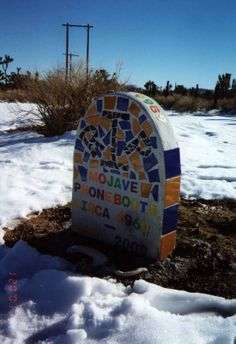Mojave phone booth
| Mojave phone booth | |
|---|---|
 An undated picture of the Phone Booth | |
| General information | |
| Status | Removed May 17, 2000 |
| Type | Phone booth |
| Location | Mojave National Preserve, California |
| Country | United States |
| Coordinates | 35°17′09″N 115°41′05″W / 35.285827°N 115.68463°WCoordinates: 35°17′09″N 115°41′05″W / 35.285827°N 115.68463°W |
| Inaugurated | 1960s |
| Owner | Pacific Bell |
The Mojave phone booth was a lone telephone booth in what is now the Mojave National Preserve in California, which attracted online attention in 1997 for its unusual location. Installed in the 1960s, the booth was eight miles (13 km) from the nearest paved road, fifteen miles (24 km) from the nearest numbered highway, and miles from any buildings. Its telephone number was originally (714) 733-9969 before the area code changed to 619 and then to 760.[1]
History
The phone booth was originally set up in 1948 to provide telephone service to local volcanic cinder miners and others living in the area, at the request of Emerson Ray, who owned the Cima Cinder Mine nearby.[2] It was part of a network of "policy stations" placed by mandate of the California government to serve residents of isolated parts of the state. The Mojave booth, at the intersection of two remote dirt roads, probably replaced an earlier booth 30 miles (48 km) to the south.[1] The original hand-cranked magneto phone was replaced with a payphone in the 1960s.[2] The rotary phone was replaced with a touch-tone model in the 1970s.[1]
The phone became a sensation on the Internet in 1997.[3] A Los Angeles man spotted a telephone icon on a map of the Mojave and decided to visit it. He wrote a letter about his adventure to an underground magazine and included the booth's ISP number. Godfrey Daniels, a local computer entrepreneur, read the letter and started the first of several websites devoted to the Mojave telephone booth.[3] Soon fans began calling the booth, and a few took trips to the booth to answer, often camping out at the site. Several callers kept recordings of their conversations. Over time, the booth became covered in graffiti left by visitors.[4]
In 1999 Los Angeles Times writer John Glionna reported on meeting a man at the booth who claimed the Holy Spirit had instructed him to answer the phone. The man spent 32 days there, answering more than 500 calls, including several from someone who identified himself as "Sergeant Zeno from the Pentagon".[3]
Removal
The booth was removed by Pacific Bell on May 17, 2000, at the request of the National Park Service. Per Pacific Bell policy, the phone number was retired. Officially, the removal was because of visitors' environmental impact on the national preserve, but pressure from locals unhappy with the increased traffic may have contributed,[1] and a letter by the Mojave National Preserve's superintendent mentions confronting Pacific Bell with some long-forgotten easement fees.[5] A headstone-like plaque was later placed at the site, but it too was removed by the National Park Service. Fans of the booth claim that Pacific Bell also destroyed the booth's enclosure.[6]
The story inspired the creation of an independent short film, Dead Line, a short documentary, Mojave Mirage, and a full-length motion picture, Mojave Phone Booth.[1] The booth was also an inspiration for the prologue of the Glenn Beck novel The Overton Window, and is the subject of a 99% Invisible podcast episode, "Mojave Phone Booth".

Revival of the phone number
AT&T's PacBell no longer owns the Baker, California +1-760-733-9XXX block of one thousand numbers, having relinquished it to competitive local exchange carrier peerlessnetwork.com on March 28, 2013, as part of a number pooling scheme.[7]
The Mojave phone booth's number, 760-733-9969, was acquired from the CLEC by phone phreak Lucky225 on July 31, 2013 and now rings using voice over IP.[8] Originally, callers joined a conference where strangers could once again connect just like when the phone booth was active.[9] At some point before May 27, 2015, it was reconfigured to play the audio book of "Exploding the Phone" by Phil Lapsley if there were no other people in a given conference. The number does not accept calls from numbers whose caller IDs are blocked or otherwise unobtainable.
IRC over SMS was added for Defcon 22 and is currently still working as well, one can send an SMS with SUBSCRIBE ALIAS to 760-733-9969 to join the group SMS chat.
See also
References
- 1 2 3 4 5 "The Mojave Phone Booth". BBC. August 16, 2006. Retrieved August 4, 2009.
- 1 2 Nystrom, Eric Charles (2003). "Chapter 6". From Neglected Space to Protected Place: An Administrative History of Mojave National Preserve. National Park Service.
- 1 2 3 Glionna, John M. (September 18, 1999). "Reaching Way Out". Los Angeles Times. Retrieved August 4, 2009.
- ↑ "What is the Mojave Phone Booth?". Wisegeek.com. Retrieved September 12, 2010.
- ↑ Martin, Mary (June 9, 2000). "NPS Correspondence".
- ↑ Xochitl666 (October 12, 2004). "The Final Fate of the Phone Booth". The Original Mojave Phone Booth Site. Retrieved April 30, 2008.
- ↑ "NPA-NXX Search". Local Calling Guide. Retrieved November 21, 2015.
- ↑ "The Legendary Mojave Phone Booth Is Back". The Daily Dot. Retrieved November 21, 2015.
- ↑ Murphy, Lorraine (August 9, 2013). "The Legendary Mojave Phone Booth Is Back". The Daily Dot. Retrieved August 9, 2013.
External links
- The legendary Mojave Phone booth is back—return of the phone number
- The Mojave Phone Booth Project—the site that originated the booth fad
- The Mojave Phone Booth Tour—a site that presents a tour of the booth
- Mission: Hang it Up
- About.com: The Mojave Phone Booth
- Desert Tripper's phone booth visits and commentary on the booth's removal
- PayPhoneBox Index of payphone numbers and photographs of payphones in unusual or famous places around the world.
- Mojave Phone Booth Overview